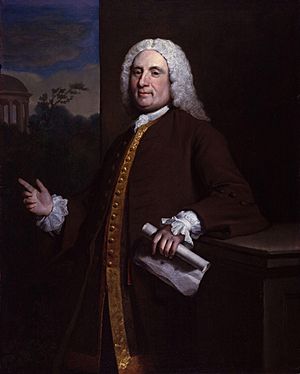Thomas Ripley (architect) facts for kids
Thomas Ripley (born in Yorkshire in 1682, died in London on February 10, 1758) was an important English architect. He designed many famous buildings in England. He started his career as a carpenter and worked his way up to become a royal architect.
Contents
Thomas Ripley's Career
Thomas Ripley began his working life in a coffee house in London. In 1705, he joined the Carpenter's Company, a group for carpenters. Even though he started as a carpenter, he became a very important architect. He worked for the king in the royal Office of Works. This office was in charge of building and maintaining royal properties.
Ripley was inspired by the Palladian style of architecture. This style uses ideas from ancient Roman and Greek buildings. Some famous architects like Sir John Vanbrugh and the writer Alexander Pope sometimes made fun of his style. They thought it was a bit old-fashioned.
Important Buildings He Worked On
One of his most famous projects was Houghton Hall for Sir Robert Walpole. Walpole was a very powerful politician at the time. Other architects, Colen Campbell and William Kent, first designed Houghton Hall. But Ripley made many changes to their plans.
In 1715, Ripley started working for the King's Office of Works. He quickly moved up the ranks. In 1721, he became the "Master Carpenter." Then, in 1726, he became the "Comptroller of the King's Works." This was a very high position. He got this job thanks to the influence of Robert Walpole. Walpole also helped him become the Surveyor of Greenwich Hospital, which Ripley helped finish.
Other Key Projects
Ripley designed several buildings for the Office of Works. These included the Custom House (built in 1718) and the Admiralty building (built from 1723 to 1726) in London. The Admiralty building is even known as the Ripley Building. He also worked on the Queen Mary Block and chapel at Greenwich from 1729 to 1750.
Later, in 1739, he worked with William Kent on designs for the New Houses of Parliament. Between 1750 and 1754, he made many changes to Kent's designs for the Horse Guards building.
Ripley's work at Houghton Hall showed he was more than just a project manager. He was responsible for adding the front porch and opening up the walkways to the garden. From 1725, he designed and built Wolterton Hall in Norfolk. This house was for Robert Walpole's younger brother, Horatio. Ripley also helped change a formal park into a more natural-looking landscape there. Until 1731, he was in charge of big changes at Raynham for the Townshend family.
Ripley was also involved in building houses in central London. He built several homes, including one at 16 Grosvenor Street. He also helped promote the plan to build Westminster Bridge.
Even though some of his public buildings were considered a bit plain, Ripley was very good at managing large projects. His practical approach helped ensure that Greenwich Hospital was completed and worked well. Ripley always cared about how practical his designs were. At Wolterton Hall, his most important work, he created a building that was simple but elegant. It showed how comfort and importance could be achieved with smart planning.
Thomas Ripley's Personal Life
Thomas Ripley married twice. His first wife died in 1737. In 1742, he married Miss Bucknall, who was quite wealthy. Ripley passed away at his home in Old Scotland Yard on February 10, 1758. He was 75 years old and left behind three sons and four daughters.
He was buried in Hampton. A painting of him by Joseph Highmore can be seen at the National Portrait Gallery. There is also a plaque at the Guildhall, London that remembers his time as Master of the Carpenter's Company.
One of his sons moved into a house Ripley had designed. It is now called Ripley House and is located at 10 Streatham Common South.
Works
- Blatherwycke Hall, Northamptonshire, 1720
- Greenwich Hospital was completed by him
- Horse Guards
- Houghton Hall
- Old Admiralty, Whitehall, London, 1723-1726
- Ripley House, at 10 Streatham Common South, London
- Wolterton Hall, Norfolk, 1727-1741


